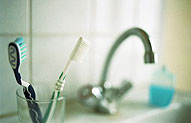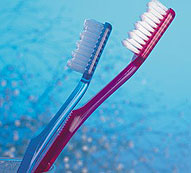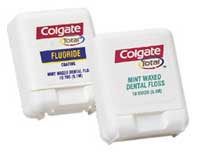|
Dental Product Review
 Oral Health Products Oral Health Products
Visit any pharmacy or the health and beauty section of a supermarket today, and you are faced with a large, and many say confusing, array of over-the-counter remedies and devices designed to help you tend to your hygiene and health-care needs.
There are many high-quality products on the market today. There also are many products of dubious value.
Whatever over-the-counter dental product you buy, it is strongly advised that you ensure it has the American Dental Association's Seal of Acceptance.
Over-the-counter dental instruments are fraught with danger. These include scaling devices and picks. Use of the products, even when following the instructions, can put your teeth and the soft tissue of your mouth at risk of tearing, bruising and other injury. You also may accidentally chip a tooth.
It is best to consult our office instead of trying to do a repair job yourself.
back to the top»
 Choosing a Toothbrush Choosing a Toothbrush
Never before has there been such a dizzying array of toothbrushes on the market. Consumers are inundated with new designs, materials, attachments, and colors.
Whatever toothbrush design you choose, the most important thing is that you use the toothbrush-at least two or three times a day. Toothbrushes accomplish one major purpose: removing plaque. A good quality toothbrush with well-made bristles will accomplish that.
Moreover, how long you spend brushing your teeth is as critical as how often you brush your teeth. Many people simply brush for a few seconds, spit, and place the toothbrush back in the cup. It is very important to spend at least 2-3 minutes brushing your teeth. This helps to ensure that the brush doesn't miss hard-to-reach or often neglected surfaces. Use short, circular motions and brush at a 45-degree angle.
Following are some tips for choosing a toothbrush:
- Choose toothbrushes with soft, round-headed bristles Avoid big-headed toothbrushes. Dental associations recommend that you buy a toothbrush with a compact head-1" by 1/2"-so you can easily reach the small areas of your mouth.
- Some toothbrushes today have wide handles. This helps you control the toothbrush better. So, choose a toothbrush with a handle that is long enough and wide enough for you to handle. You should replace your toothbrush at least four times a year-more often if you have been sick.
Electric vs. Manual Toothbrushes
There are a wide variety of electric toothbrushes on the market today. Some are even disposable. A few models have even received positive reviews by the American Dental Association.
Electric toothbrushes, for the most part, can be just as effective as the old-fashioned, non-powered varieties. Some studies have shown electric toothbrushes cover more area quickly because of their rapid, rotating bristles.
If only the novelty of them, electric toothbrushes may encourage more frequent brushing among people who normally hate to brush. They also may be advantageous for people who have arthritis, or for children with braces who find it more difficult to navigate around the appliances with a manual toothbrush.
A few things to remember about electric toothbrushes: Some are expensive; nearly all cost more than a conventional toothbrush. They also require recharging. And most people who use an electric toothbrush for the first time may experience a little bleeding from the powerful bristle action on their gums. In most cases, the bleeding will stop after a few uses.
back to the top»
 Types of Floss Types of Floss
Dental floss comes in a variety of colors, materials and even flavors. Waxed varieties are slipperier, allowing people with extremely tight spaces between their teeth to floss more easily. Popular flavors of floss include wintergreen and cinnamon. Waxed floss does tend to fray more than unwaxed floss.
A type of material called wide floss can be effective for people with large spaces between their teeth, or for people with delicate bridge work.
Floss can be purchased in small self-dispensing boxes. Floss can also be purchased in special, single-use holders, which are useful for people who have a hard time wrapping floss around their fingers, including those with dexterity problems or arthritis.
back to the top»
Water Picks
There is never a suitable substitute for daily brushing and flossing.
While some products, including water irrigation devices (or "water picks"), may be useful for specific applications, they do not accomplish one major task: removing plaque.
Water picks use powerful tiny bursts of water to blast away food particles and other debris in hard-to-reach areas of your mouth. Dentists use professional-grade water picks when preparing a tooth for restoration, or in general cleaning and exams.
People with painful gum disease or highly sensitive gums may find water picks useful for supplementing their brushing regimen. And people with orthodontia, including braces, have found water picks quite useful because toothbrush bristles often get stuck.
back to the top»
Mouth Guards
Mouth guards are an important piece of gear for various other kinds of physical activities and sports-from rollerblading to downhill sledding. Hundreds of thousands injuries occur every year involving the face and mouth-injuries that many times could be avoided or minimized if a mouth guard had been worn, according to the U.S. Consumer Product Safety Commission.
Mouth guards provide valuable protection for the jaw, face, tongue, lips, and of course, teeth. For example, a traumatic blow to the front of the face can not only tear soft tissue or knock out teeth, but also may force the lower jaw into the upper jaw. A mouth guard can help keep your teeth from tearing the soft tissues of your mouth during a traumatic injury. And in all cases, mouth guards can protect you when you're wearing bridges or braces.
Mouth guards are generally small plastic appliances that safely fit around your teeth. Many mouth guards are soft and pliable when opened, and mold to your teeth when first inserted.
Mouth guards can help prevent a whole host of traumatic injuries to the neck and jaw, as well as more serious problems such as cerebral hemorrhages and concussions.
Types of Mouth Guards
Mouth protectors come in basically three different types or designs:
- One of the most common mouth guards is the kind you soak in hot water and then mold to your teeth.
- Custom-fitted mouth guards are usually made by your dentist, and as such, provide a much greater measure of confidence in their ability to protect your mouth and other facial structures.
- The least attractive option are pre-molded mouth guards you typically find in point-of-sale aisles at sporting goods stores. These may be ready to wear, but because they are not molded to the unique shape of your teeth and mouth, can easily become dislodged.
Care for Your Mouth Guard
Your mouth guard needs to be cleaned (usually with warm soap and water) and allowed to air dry after each use. You also can soak your mouth guard in an antiseptic mouthwash to help remove many kinds of germs.
If you don't regularly clean your mouth guard, bacteria and other germs will grow on the device and enter your mouth the next time you use the guard, making you vulnerable to infections.
back to the top»
back to Family Dentistry
|
